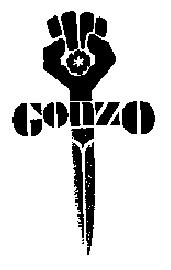

Well, I just found out minutes ago that Hunter S Thompson is dead. This is terrible news for me because he was a god to me. I am sad and torn and will deal with this the way I deal with everything - writing to you about it.
Really, no one can be surprised by news of Hunter's death. Hunter lived a long a very crazy life... you know that. What is a freakish surprise to me is the news is it was a suicide. What the fuck is that about, Hunter? It seems a cowardly way to go for such a brave and fearless man. For the last month I have been reading his last tome 'Kingdom of Fear'. I was on the web writing about Hunter on Blogcritics this afternoon (before I knew about his death). It was just today... about 6 hours ago I typed this very line "Hunter Thompson is the greatest living American writer".
Lemme tell you about my attachment and love of HST. If you have a working browser (like Mozilla) you have seen a black fist that says 'Gonzo' on the left under the links. That was an homage to Hunter for my site. In college, I had vanity plates on my Honda that said 'Lono'. This is a Hunter Thompson reference as well. Hunter is one of the reasons I moved to Colorado, seriously. I wanted to meet him, and knew eventually I would make my way to Woody Creek Tavern for an unpleasent drunken exchange with the man. In fact, if you could see that Atlas we used to drive to Colorado about 9 years ago... there is only one pen mark on the Colorado page. I circled Woody Creek to show my wife where Hunter lived, and where we would subsequently be stalking.
I am pleased to say I did get to finally see him in person. A year or two after we moved here he did a speaking engagement at the Fox Theatre in Boulder. It was a classic Hunter experience, and I was able to ask him a question personally. I'd have to say I am somewhere in the 'denial' stage still about this news. I keep refreshing my google news search engine every few minutes hoping to see the word 'hoax' somewhere. It hasn't happened yet. There will be a million pages and writings dedicated to Hunter over the coming weeks and months. However, there is only one good internet site dedicated to Hunter for years, it is Christine's 'Great Thompson Hunt' and that is where you should go for pictures and articles and news.
You see my sig file and e mail address? They are the name 'Lono'. I own that name in almost every domain over the years (ATT, Us West, MSN, Hotmail, & Mindspring). This is all a reference to one of Hunter's greatest books 'The Curse of Lono'. I am sure I will have more to say about this, much much more. For now, at 11 pm Colorado time, the news has only been public for about an hour. The details are chillingly few: Hunter Thompson found dead of apparent self inflicted gunshot wounds, found by his son Juan.
You all know about Roy if you are here often enough. This is what Roy wrote to the group this evening about this news: This is sad and a loss I put equal to the death of John Lennon. So perhaps you can see why Roy and I are so close. In fact, I just remember Hunter is the REASON I met Roy. Roy had one of the good doctor's books at his desk at work and it caught my eye. Knowing anyone who reads Hunter is good people, we struck up a conversation. If it weren't for that book, I probably wouldn't know or subsequently care about my very good friend Roy.
PT 2, written about an hour (and three drinks) later
The last piece I wrote about Hunter was ironically titled 'Hunter S Thompson, still alive' That was back in August. I knew one day Hunter would be gone and we'd all sit and talk about how great he was. I didn't want to wait until he was dead for people to appreciate him... so I reached out. Hunter was like Jerry Garcia, you just know neither was ever going to live out a full life to old age. I miss them both so much.
I also want to say this. We all knew Hunter could go any day. What I expected was a headline like this "Gonzo journalist shot by police after consuming hundreds of hits of LSD and attempting to paint murals on Aspen police cars" or something cool and strange like that. I guess I wanted an Easy Rider type ending... a martyr who fought to the end.

